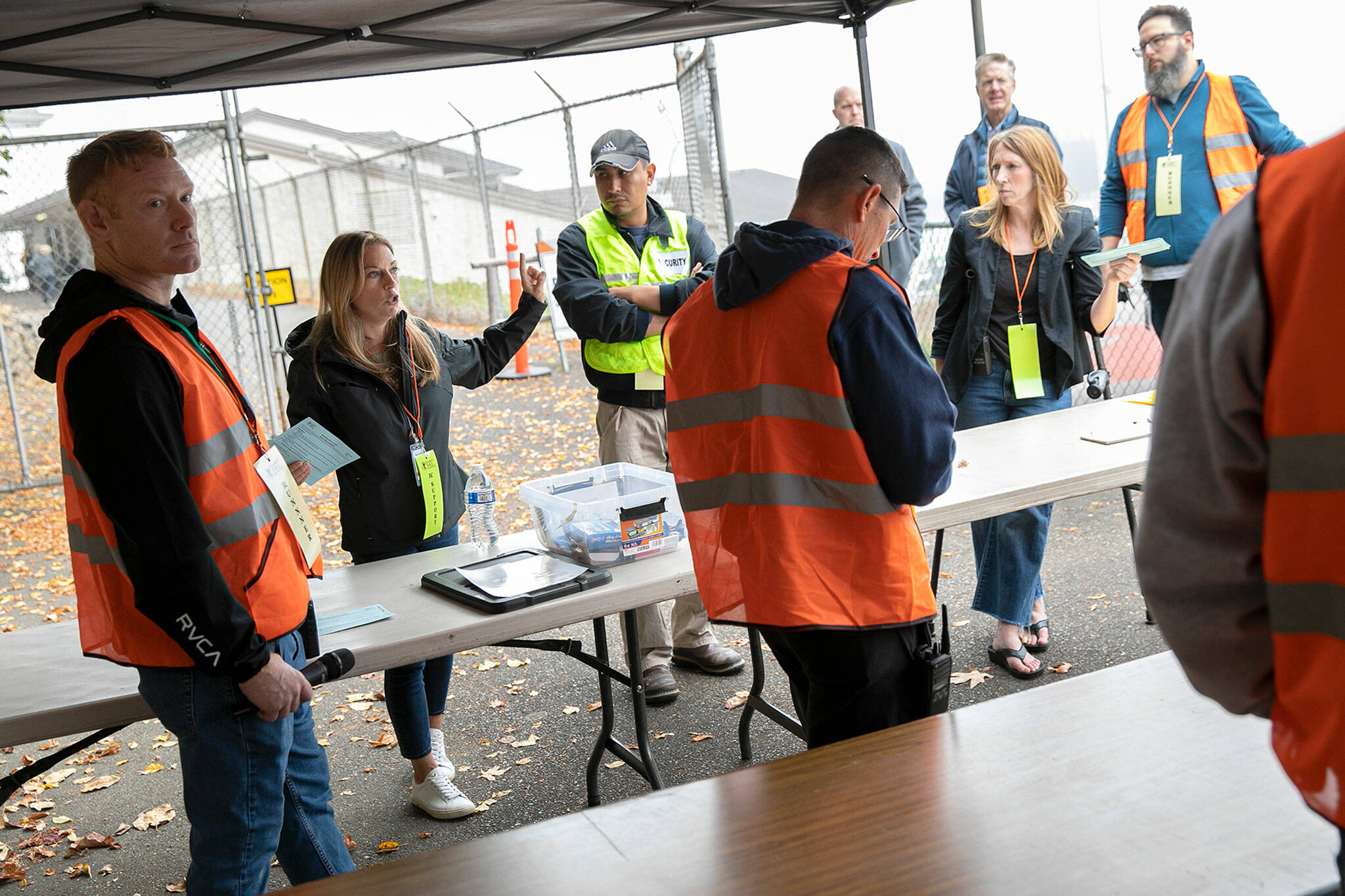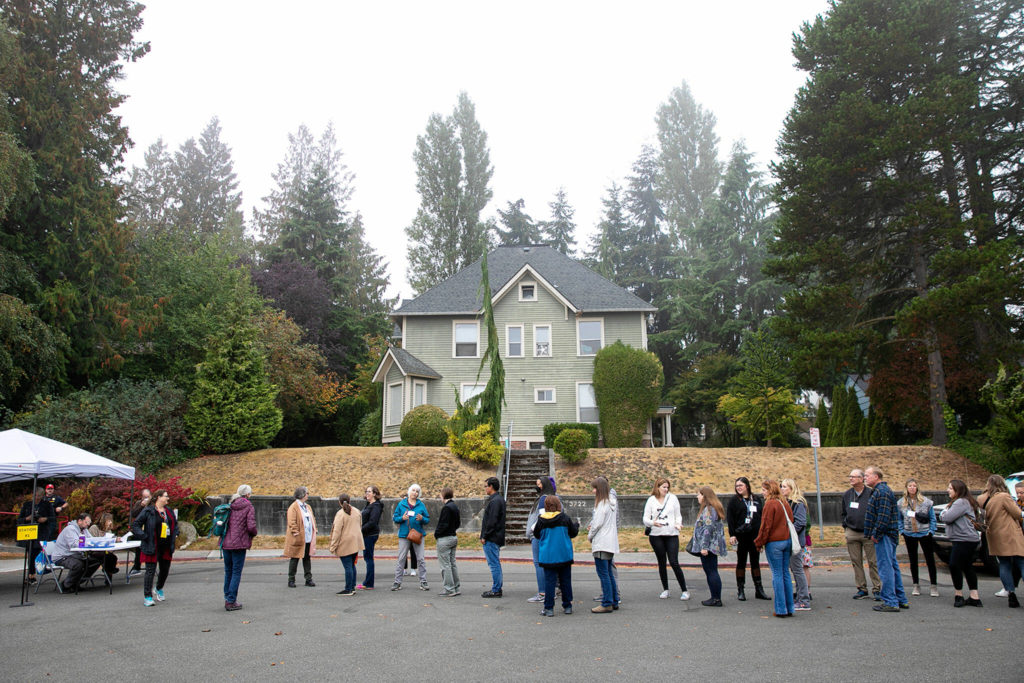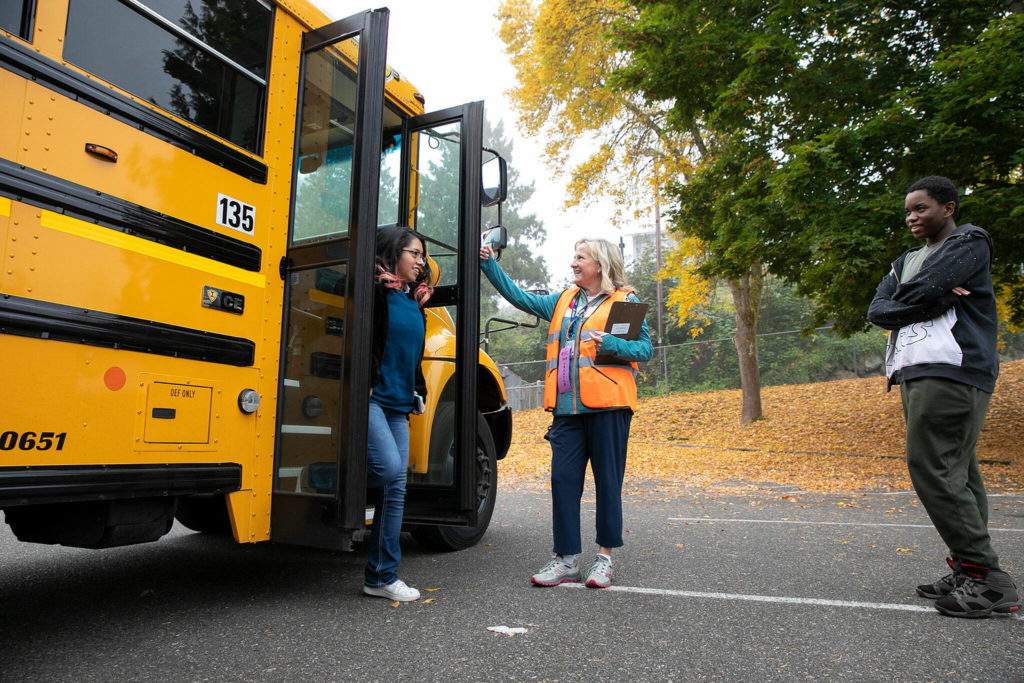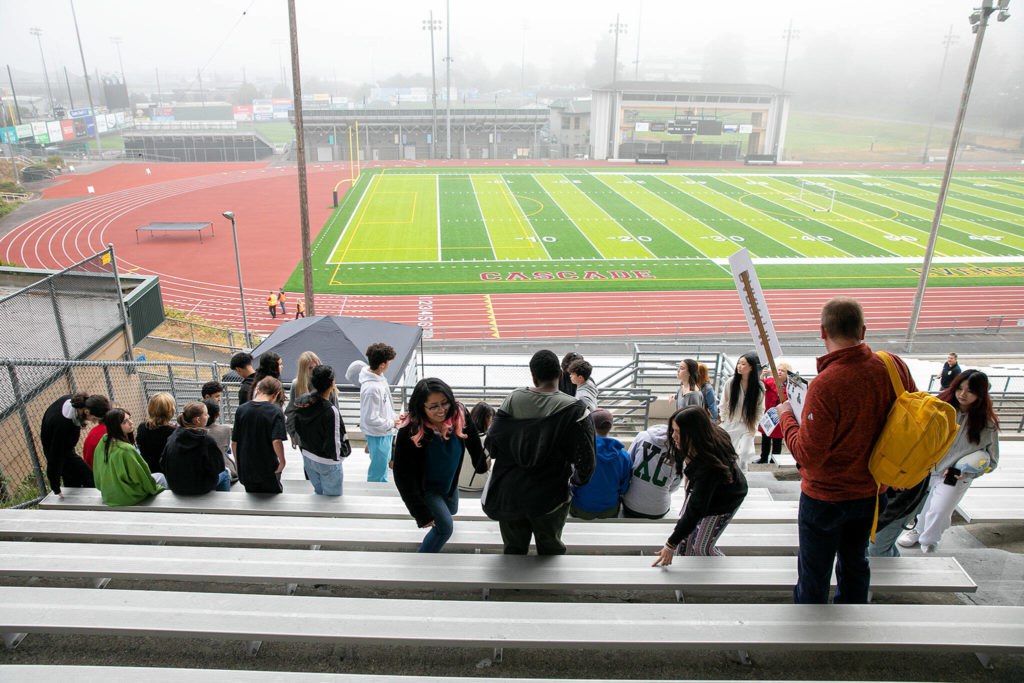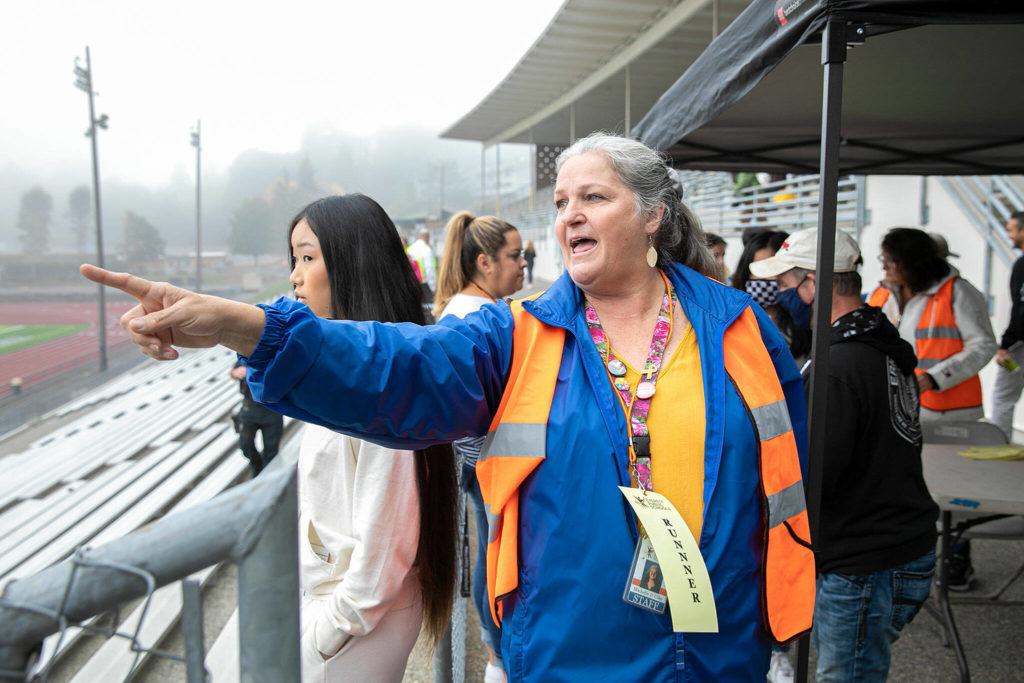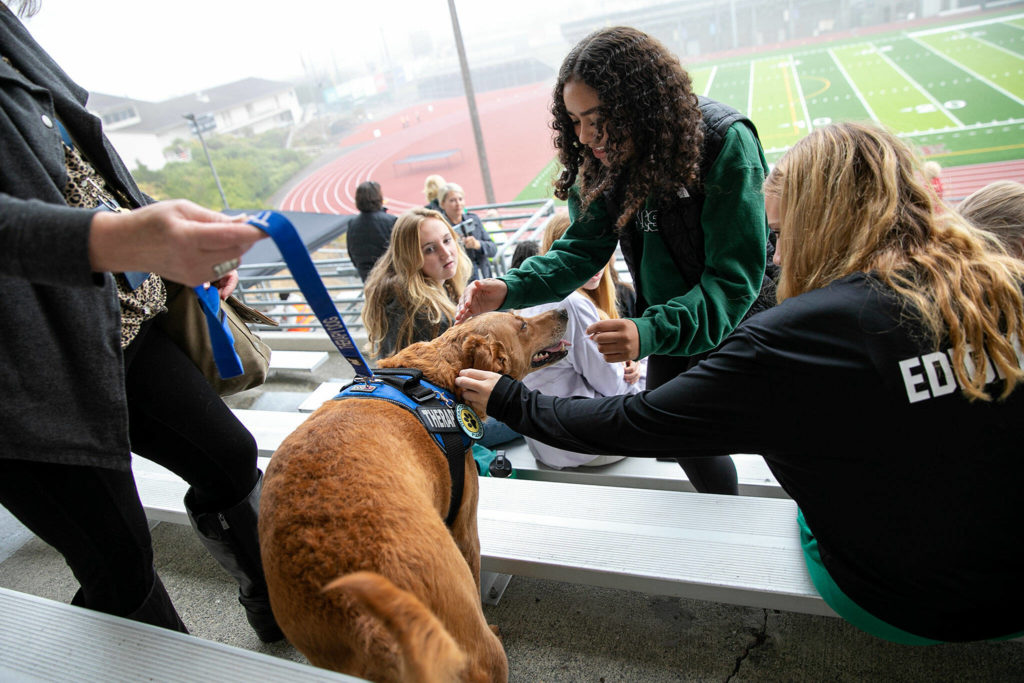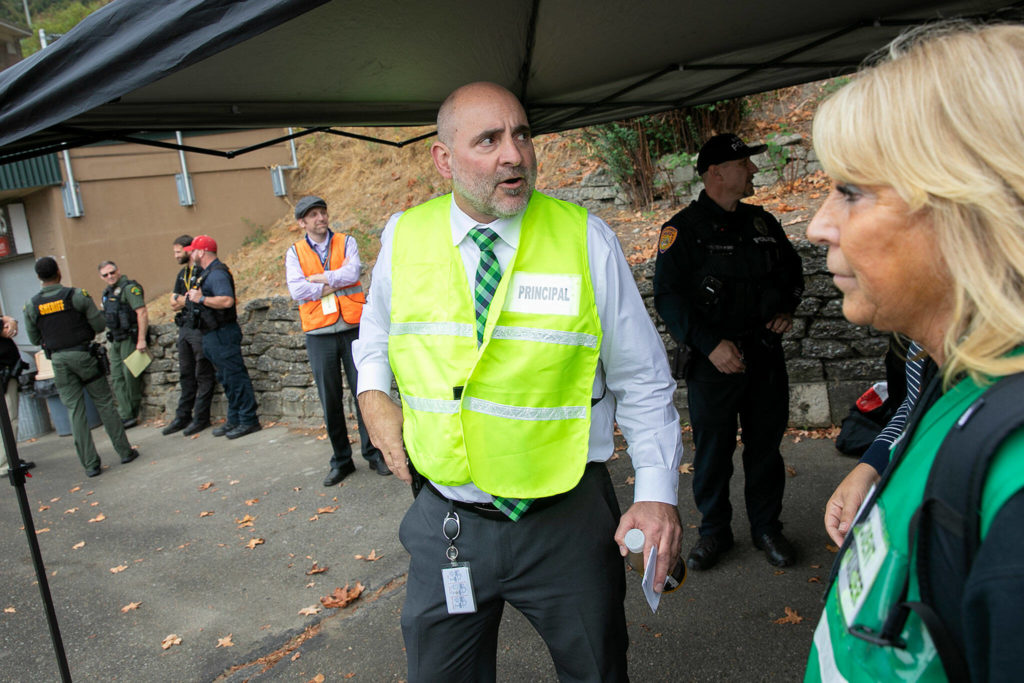EVERETT — At 9:30 a.m. on the dot, Kathy Reeves’ work and personal cell phones both received the same call.
From the grounds of Everett Memorial Stadium on Thursday, the Everett Public Schools spokesperson pulled a phone from her left pocket and set it on speaker.
“This is (Superintendent) Ian Saltzman activating the reunification exercise,” a pre-recorded message played into the foggy morning. “Anyone assigned to a position … please report to the athletics building for further instruction.”
Moments later, employees at the district office strolled to the nearby football field. For the drill, Reeves estimated 120 people left their work desks, walked across the south stadium parking lot and assumed their positions.
From there, they directed about 90 students and 50 “surrogate parents” through a special safety drill that simulated students reuniting with their guardians after evacuating off campus.
The drill, normally scheduled once every two years, had not been held since 2018 because of the pandemic, said Christopher Ferreira, the safety and security director for Everett Public Schools.
“Reunification” is a relatively rare practice at public schools, usually reserved for two reasons: chemical spills at or near a school, or an active shooter on campus. It’s something Ferreira hopes his colleagues never need to do in real life, but practicing helps the district to ensure the process runs smoothly, should an emergency arise.
“It’s always important in emergency management … to not just totally rely on lecture or presentation-based learning,” Ferreira said. “We also do practical exercises because the practical portion is really where you build competency and confidence. … Practice is what highlights what you’re doing that’s working well in your systems and what you’re doing that can be improved.”
Representatives from schools in Mukilteo, Sultan, Northshore and Renton observed, along with law enforcement officers from Everett, Mill Creek and Snohomish County.
As the drill began Thursday, staff at Henry M. Jackson High School gathered students from their classrooms. Employees and students had been notified in advance about the drill.
“It’s not a traditional simulation where you come up with a scenario,” Ferreira said. “It’s a practice of our process. … For reunification specifically, it’s more important that we build confidence and competence in the process than it is to add a bunch of stimuli.”
Students traveled 8 miles in buses to the stadium, the district’s designated spot for off-campus evacuations. Reeves said the stadium works well for a number of reasons.
It is equipped with seating, storage and restrooms, and it is big enough to hold thousands of people. In the hypothetical example of a neighborhood gas leak that causes an evacuation from Jackson and nearby Heatherwood Middle School, school officials said nearly 3,500 kids would need to be reunited with parents.
The stadium also offers natural “ingress and egress” points to keep each part of the process separate and orderly. Students enter the stadium at one entrance, and parents in another. Once together, the families are asked to leave from a third location, so no one runs into each other.
And with the district office just a short walk away, the stadium comes with a sort of built-in response team.
“This is the only place you automatically have 200 staff there to help,” Reeves said.
Once the buses arrived at the stadium Thursday, teachers led their students from the parking lot into the stands. They handed off attendance sheets to staff acting as an incident command team.
Meanwhile, “surrogate parents” played by school volunteers and staff arrived on the other end of the stadium.
To pick up their kids, adults went through a series of “stations.” They signed in at a “welcome” table, then went through about three stops to check and double-check their identity, their children’s identities and their children’s presence in the stadium. They also filled out special paperwork that helps track which students have been picked up and by whom.
Once staff verified who was present and confirmed the adult as an emergency contact, they called students’ names over a microphone. The parent walked with a staff member to meet with the kids.
School Board member Jen Hirman attended as a surrogate parent, waiting to meet two students assigned to her.
When Hirman, a mother of two teen daughters in real life, arrived at a check-in table, staff told her one of the students was ready but the other hadn’t arrived. She later told The Herald that even though it was a drill, she couldn’t help but “thinking with my parent hat” about the worst-case scenario.
She knows there are many reasons why a child might not be in the stadium. Maybe the student drove their own car to school and decided to just drive home, instead of boarding the bus. Maybe their bus was stuck in traffic.
In an actual emergency, she would probably get a text or call from her daughter with more information, she said. Still, practicing the drill helped her to better prepare.
“You can’t plan for everything, but you still think of a plan as best you can,” Hirman said. “Hopefully (this drill) does ease everyone’s mind that there are plans in place, and we are working with local authorities to improve.”
Hirman said she attended a drill about six years ago, and she noticed some improvements the district made based on the previous practice. During her last drill, parents did not learn if their student was in the stadium until the third station they went to. This year, they were told immediately at check in.
That kept the pick up process “secure and orderly,” so no parent was turned back halfway through because their kid hadn’t arrived yet, Hirman said.
Throughout the drill Thursday, staff members and parents talked through each hiccup. If a line backed up or a staff escort ran behind, they corrected problems in real time and made notes.
When the drill finished at 10:50 a.m., Ferreira gathered the volunteers and staff to debrief and share ideas for improving the process further. The group will also take a follow-up survey, so Ferreira can “get 100 people’s perspectives” on how things went, he said.
The district will run the drill again in about two years, as is “best practice,” Ferreira said. He also leads annual trainings for all school staff. Resources are available on the district’s website for parents to review as needed.
Mallory Gruban covers K-12 education for the Daily Herald. She is a corps member with Report for America, a national service initiative that places journalists in local newsrooms, To learn more or to support Mallory’s work with a donation, go to heraldnet.com/education-project-fund.
Mallory Gruben: 425-339-3035; mallory.gruben@heraldnet.com; Twitter: @MalloryGruben
Talk to us
> Give us your news tips.
> Send us a letter to the editor.
> More Herald contact information.
